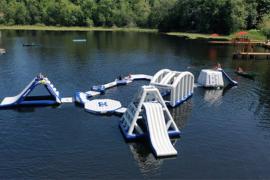In the past decade, aquatic facilities across the country have adopted Test, Mark, Protect policies as a core set of strategies to reduce risk, and to set clear expectations for anyone wanting to swim. There’s a reason for that. By their very nature, aquatic activities present a complex set of risks and challenges, and because the outcome of any lapse in safety is potentially lifechanging or even fatal, it’s important to have multiple safeguards in place in order to minimize risk.
Undoubtedly, lifeguards play a critical role in protecting the water. They provide eyes and ears to look for anyone in trouble, and they serve as the first line of response if something does go wrong. This is heroic work, but it’s important to set our lifeguards up for success. The best way to do this is by removing as much potential uncertainty from the equation as possible by managing who has access to the water, and under what conditions.
When properly and fully implemented, Test, Mark, Protect policies make it easier for guards to remain rescue ready and focused on watching the water. And they do this by applying a multi-layered approach that includes:
- Test: This means testing anyone who wants to be in the water.
- Mark: Meaning everyone who has been tested is marked according to their current swimming ability, usually with red and green bands or other markings.
- Protect: Non-swimmers are restricted to shallow water during free swim. Additionally, they are required to wear a properly fitted US Coast Guard approved life jacket, unless they are within arms’ reach of an adult or they are actively engaged in a swim lesson.
While these policies are increasingly considered best practice within the aquatics industry, we regularly hear from camp directors and aquatics staff that there are specific challenges to implementing these policies at camp. These challenges include:
- Culture: Camps are places of safety, inclusivity, and acceptance. Many camps are concerned that marking non-swimmers can be stigmatizing, and they are reluctant to implement policies that may make campers feel embarrassed or singled out in the presence of their peers.
- Consistency with mission: Camps exist to create opportunities for growth and adventure. Some camps have expressed a concern that restricting non-swimmers to the shallow end will prevent them from building their swimming skills.
- Resources: Camps have always had to contend with a million different demands on time and resources. Adding swim testing and marking to the tasks of an already stretched team can feel like a daunting stretch, especially in a tight labor market where camps may be short staffed already.
The good news is that, despite these challenges, many camps are already implementing multiple layers of protection when it comes to aquatic safety. In fact, on a recent camps webinar on this topic, the vast majority of attendees reported implementing all three pillars of the Test, Mark, Protect approach. Many of the remaining camps were already swim testing in some form, meaning that the foundations are in place for expanding those policies to a more robust and complete set of protections.
Swim Lessons Are Different
According to Meredith Stewart, a Redwoods Consultant and former camp director, the first thing she emphasizes to camps is that while Test, Mark, Protect is critically important during "free swim," it actually applies to all swim times, albeit in sometimes adapted form. For example, if a non-swimmer is actively engaged in a swim lesson, then rules around access to deeper water, or wearing a flotation device, should be modified according to the needs of the lesson:
"Sometimes I hear from camps that you can’t learn to swim with a life jacket on. And that can be true. In fact, we encourage camps to provide swim lessons where non-swimmers can stretch their abilities, and to try swimming without a life jacket. The key is to differentiate between times of active learning, and times when campers are free to just enjoy the water and swim with their friends."
Adapting Policy to Camp Culture
Additionally, Meredith says, the key to successfully adopting a holistic approach to Test, Mark, Protect, is to first understand that camps are indeed different to aquatic centers or regular swimming pools, and to adapt your policies to fit the needs and culture of your camp:
"I totally understand why some camps are concerned about stigmatization, or about putting barriers in the way of learning how to swim. But these concerns don’t have to get in the way of having a robust approach to Test, Mark, Protect. Many camps have found ways to message the policy that fits with camp culture. They might use the term ‘swim assessment’ instead of ‘test,’ for example, or refer to ‘emerging swimmers’ rather than ‘non-swimmers.’ And they will be intentional about celebrating all progress toward the ultimate goal of becoming a competent and confident swimmer."
According to Meredith, this focus on progress can help to reduce stigma, and to create a culture where everyone is encouraged to grow. Some camps, for example, will require everyone to start out as a non-swimmer, and then to work with each camper to set goals that are personal, and relative to their current ability. It can also help to insist that red and green bands are only worn during swim time, thus reducing the idea of swimming ability as a marker of status—as opposed to a skill that everybody is working on.
Another strategy that some camps have used is to clearly and demonstrably mark staff according to their swimming ability, with non-swimmer staff playing an important role in showing campers that there is no shame attached to not being able to swim.
Encouraging Empathy
Above all else, says Meredith, it is vitally important to train staff on how to talk with all campers about Test, Mark, Protect policies, and to build a culture that encourages everybody to challenge themselves, while being accepting that we all have different skill levels:
"It's one thing to tell staff that non-swimmers have to stay in the shallow end and wear a life vest. It’s another to ask staff to apply empathy when talking about these rules, to encourage a culture of encouragement and acceptance, and to work with every camper on setting real, achievable and personalized goals for improvement."
The core point of Test, Mark, Protect at camp is not to coddle campers or to apply unnecessary barriers to swimming. Instead, says Meredith, it’s to create a comprehensive, consistent and practical approach to aquatic safety that encourages everyone — regardless of current swimming ability — to both push themselves to improve, and to celebrate improvement among others, while still keeping a focus on safety.
The Challenge of Implementation
Of course, it can seem challenging to implement additional layers of policy and practice when staffing is already stretched. However, there are ways to help ease the burden—for example by making sure that counselors and staff are actively engaged in supervision during swim times, or in training them to help administer swim tests so that lifeguards can continue guarding the pool. And if resources really are stretched too thin, camps will sometimes reduce swim times or adapt programming to make sure that access to water can be maintained in a safe and orderly manner.
Ultimately, Meredith says, these policies and practices, once they are established, will actually help to make supervision easier and more effective than it was before:
"Camp directors are basically magicians when it comes to doing more with less. And while Test, Mark, Protect, might seem like ‘yet another demand’ on limited time and resources, the opposite is actually true. Once these policies are in place and consistently applied, they help lifeguards and counselors alike to know who is supposed to be where in terms of access to the water, and how we can help them to progress. With parents increasingly demanding to know more about how their kids are being protected, it also becomes a marketing tool—helping you to communicate both the care you take with their loved ones, and also how you will help them to grow their skills, and to come back from camp as stronger and more confident swimmers."
This blog was provided by The Redwoods Group.
Photo credit: CindyMurray/iStock via Getty Images.
Periodically, the American Camp Association (ACA) makes timely and relevant information about products and services available to its members so they can make informed decisions for their camps. However, the ACA does not endorse products, services, or companies.
The views and opinions expressed by contributors are their own and do not necessarily reflect the views of the American Camp Association or ACA employees.




